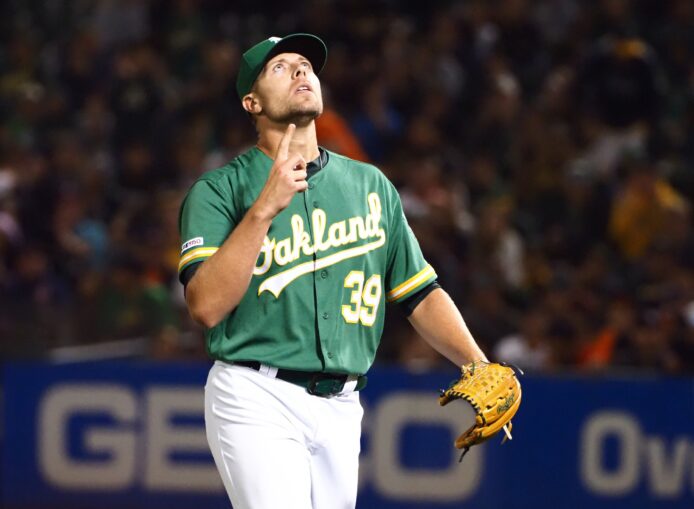
As MLB’s non-tender deadline came and went on Monday, a bunch of big leaguers were added this winter’s free-agent market, including a number of players with names we’re familiar with. There are plenty of newly-minted free agents the New York Mets will have an interest in, and one that immediately comes to mind is former Oakland Athletics closer, Blake Treinen.
Treinen’s trajectory over the past couple years is a reminder of how humbling baseball can be. He excelled in Oakland after landing there in the middle of the 2017 season and followed that with a ridiculous 0.78 ERA and 2.46 SIERA, along with a 31.8% strikeout rate, 6.7% walk rate, and 3.6 fWAR in 80.1 innings in 2018. Yet here we are, a year removed from a performance that earned him some American League Cy Young votes, and he’s currently looking for work. A 4.91 ERA (with a 5.01 SIERA), 13.9% walk rate, 1.38 homers allowed per nine innings, and a -0.3 fWAR in 58.2 innings will do that, though.
If both Edwin Diaz and Jeurys Familia are taking up space in the Mets’ bullpen come Spring Training, New York will have its hands full getting those two to bounce back after rough performances of their own. Adding another rebound candidate may be a bit much, but it’s easy to see the appeal for a hurler who has enjoyed recent success and is trying to rebuild his value before heading back out into the open market.
So what exactly went wrong for the right-hander this past season?
What Went Wrong
There are plenty of places to sift through when looking areas that need to improve. His 17.8% soft-hit rate decreased for the third straight year and was just barely above the league-average rate for relievers. His 36.7% hard-hit rate allowed was still better than league average, but it increased by almost eight percentage points compared to the year before. His walk rate just about doubled, his strand rate dropped by about 10 percentage points, and his homers allowed per nine innings rate went from 0.22 in 2018 to the 1.38 mark he finished with in ’19.
What’s interesting here, though, is that Treinen posted a 61.3% first-strike rate (a career-best mark), along with a 37.8% zone rate (a career-worst mark). Getting strike one wasn’t the problem — it seemed like a lot of other things were. However, it was the 31-year-old’s shift in pitch mix in recent years is what caught my own when looking through everything.
Since throwing his slider at a career-high 30.4% rate in 2016 with the Washington Nationals, that number has gone down each year, with his usage rate coming in at just 13.3% in 2019. Conversely, Treinen has been using a cutter with increased frequency: 0.5% in ’17, 11.8% in ’18, and 19.7% in ’19. Between the four pitches he threw this past season (four-seamer, sinker, cutter, slider), the slider was both his least used and most effective pitch when looking at wRC+.
Opposing hitters mustered a 78 wRC+ against that offering last year, with none of Treinen’s other three pitches producing an opponent wRC+ below 104 (none of these pitches produced a wRC+ above 58 in 2018, just for comparison’s sake).
Although Treinen’s walk rate went up across the board for each pitch in his arsenal, his sinker wasn’t his biggest problem (7.2% in ’18 to 10.3% in ’19) — it was his four-seamer. After producing a 9.0% walk rate with that pitch during his breakout 2018 season, that number jumped up to an alarming 28.8% (with his strikeout rate going from 32.8% to 21.2%). Another drastic change took place with that cutter. His walk rate for this offering went from 3.4% to 10.2%, while his strikeout rate went from 34.5% to 45.9%.
Even though it was a step back from the prior season, his slider still wasn’t too shabby when considering the circumstances (walk rate went from 1.3% to 5.4% and strikeout rate went from 58.7% to 48.5%).

Looking Ahead and Overall Fit
Of course, the answer isn’t necessarily as simple as, “Well, then he should just throw more sliders.” That may be part of the answer, and if it is, being in an environment where another fellow reliever (Diaz) is trying to recapture his magic with that pitch may not be the worst thing in the world. And let’s not forget that throwing more sliders ended up being a clear second-half trend for the Mets’ entire starting rotation.
Improving the bullpen — regardless of whether Diaz and Familia stick around and bounce back — is one of the Mets’ biggest offseason priorities. The free-agent market for relievers isn’t super deep and a number of available hurlers have already been signed by other teams. The financial flexibility (read: willingness) to stretch for those on the open market may not be there, but it’s not as if trying to overpay for someone like Kirby Yates or Josh Hader makes sense (and for Hader, there are other reasons there, too). After all, we just saw how that worked out in a similar situation by acquiring Diaz and Robinson Cano in exchange for a number of the organization’s top prospects.
Instead of sacrificing more prospect capital for a player’s performance that’s far from a guarantee, it’d be interesting to see the Mets throw their hat in the ring for Treinen’s services since the only thing they’d be surrendering by taking this risk is cash. Depending on how his market ends up forming, the righty’s asking price will at least be in a range New York is willing to sacrifice.















